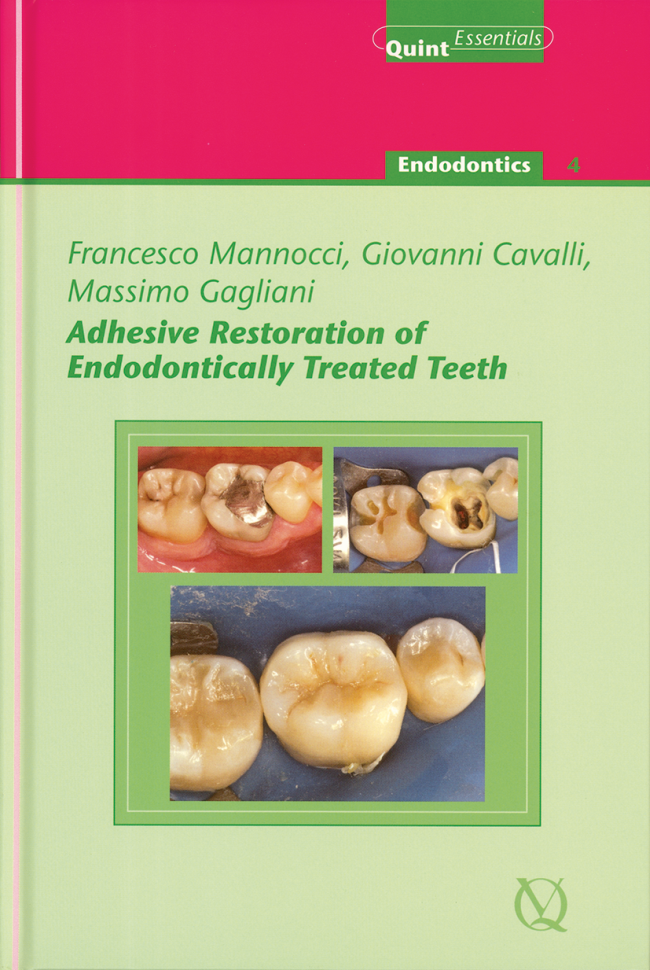International Journal of Esthetic Dentistry (EN), 4/2017
ID de PubMed (PMID): 28983535Páginas 524-535, Idioma: InglésScotti, Nicola / Cavalli, Giovanni / Gagliani, Massimo / Breschi, LorenzoNowadays, adhesive dentistry is a fundamental part of daily clinical work. The evolution of adhesive materials and techniques has been based on the need for simplicity in the step-by-step procedures to obtain long-lasting direct and indirect restorations. For this reason, recently introduced universal multimode adhesives represent a simple option for creating a hybrid layer, with or without the use of phosphoric acid application. However, it is important to understand the limitations of this latest generation of adhesive systems as well as how to use them on coronal and radicular dentin. Based on the findings in the literature, universal multimode adhesives have shown promising results, even if the problem of hybrid layer degradation due to the hydrolytic activity of matrix metalloproteinases (MMPs) still exists. Studies are therefore required to help us understand how to reduce this degradation.
International Journal of Esthetic Dentistry (DE), 4/2017
Páginas 516-527, Idioma: AlemánScotti, Nicola / Cavalli, Giovanni / Gagliani, Massimo / Breschi, LorenzoAdhäsive Restaurationen sind mittlerweile ein grundlegender Bestandteil der täglichen zahnärztlichen Arbeit. Weil der Wunsch nach einer Vereinfachung der Protokolle für direkte und indirekte Versorgungen mit langfristiger Bewährung besteht, werden adhäsive Materialien und Techniken entsprechend weiterentwickelt. Kürzlich eingeführte Multi-mode-Adhäsive bieten eine simple Möglichkeit dafür, eine Hybridschicht zu erzeugen, und zwar sowohl mit als auch ohne das Ätzen mit Phosphorsäure. Dabei ist es notwendig, die Grenzen dieser jüngsten Generation von Adhäsivsystemen zu kennen und zu verstehen, wie sie auf Kronen- und Wurzeldentin anzuwenden sind. Die Daten in der Literatur bestätigen für Multi-mode-Universaladhäsive vielversprechende Ergebnisse, auch wenn das Problem der Hybridschicht-degradation aufgrund der Aktivität von Matrix-Metalloproteinasen weiterbesteht. Um zu verstehen, wie diese Degradation verhindert werden kann, sind weitere Untersuchungen gefragt.
The Journal of Adhesive Dentistry, 5/2013
DOI: 10.3290/j.jad.a28734, ID de PubMed (PMID): 23534020Páginas 431-438, Idioma: InglésBrambilla, Eugenio / Ionescu, Andrei / Fadini, Luigi / Mazzoni, Annalisa / Imazato, Satoshi / Pashley, David / Breschi, Lorenzo / Gagliani, MassimoPurpose: To evaluate the activity of a methacryloyloxydodecylpyridinium bromide (MDPB)-containing self-etching primer (Clearfil Protect Bond) against Streptococcus mutans and its ability to reduce biofilm formation on standardized experimental Class I restorations in vitro.
Materials and Methods: Forty experimental Class I round restorations were prepared on enamel-dentin slabs using different adhesive strategies: group 1 = MDPB-containing adhesive system (Clearfil Protect Bond); group 2 = MDPB-free self-etching adhesive system (Clearfil SE Bond); group 3: MDPB-containing self-etching primer in combination with a fluoride-free bonding agent; group 4: MDPB-free self-etching primer in combination with a fluoride-containing bonding agent; group 5: a three-step etch-and-rinse adhesive system (Adper Scotchbond Multi Purpose). A Streptococcus mutans biofilm was grown for 48 h on the restoration surfaces and subsequently evaluated using scanning electron microscopy on three different areas: enamel, composite, and interface surfaces. Statistical analysis was performed by multiple ANOVA after data transformation.
Results: Specimens in groups 2, 4 and 5 showed greater biofilm formation than those in groups 1 and 3 (p 0.001) on all investigated substrates (enamel, composite, and interface areas).
Conclusions: Specimens prepared with an MDPB-containing primer exhibited significant decreases in biofilm formation on Class I restorations in vitro. Further in vitro and in vivo studies are required to clarify the role of quaternary ammonium compounds in reducing bacterial biofilm formation on restoration surfaces.
Palabras clave: dentin bonding agents, MDPB monomer, antibacterial agents, biofilms, Streptococcus mutans
The Journal of Adhesive Dentistry, 3/2011
DOI: 10.3290/j.jad.a19742, ID de PubMed (PMID): 21246078Páginas 279-286, Idioma: InglésAcquaviva, Pier Antonio / Madini, Lorenzo / Krokidis, Andreas / Gagliani, Massimo / Mangani, Francesco / Cerutti, AntonioPurpose: To determine, by means of a non-destructive experimental procedure, the effectiveness of adhesive restorations in reducing the cuspal deflection of endodontically treated premolars, with or without root canal fiber posts.
Materials and Methods: The cuspal deflection of ten sound, intact maxillary premolars was evaluated. A loading device induced deformation by axial force (ranging from 98 to 294 N) applied on the occlusal surface of teeth while laser sensors registered the amount of deflection. Once tested, teeth were endodontically treated and the marginal ridges were removed. The teeth were randomly divided into two groups and restored with: group 1) dual curing adhesive, flowable composite, and microhybrid composite; group 2) the same materials associated with root canal glass fiber post and composite cement. The cuspal deflection test was repeated with the same protocol after restorative procedures, allowing a direct comparison of the same samples. Statistical analysis was performed using ANOVA at a significance level of 0.05.
Results: Different average cuspal deflection was detected in the two groups: composite resin with post insertion resulted in lower deformation compared with composite alone. Mean deflection ranged from 3.43 to 12.17 µm in intact teeth, from 14.42 to 26.93 µm in group 1, and from 15.35 to 20.39 µm in group 2. ANOVA found significant differences (p = 0.02).
Conclusion: Bonded composite restorations with fiber posts may be more effective than composite alone in reducing the cuspal deflection in endodontically treated premolars in which the marginal ridges have been lost.
Palabras clave: fiber post, cuspal deflection, resin-based composite (RBC) restoration
ENDO, 3/2009
Páginas 227-234, Idioma: InglésRe, Dino / Augusti, Davide / Cerutti, Francesca / Gagliani, Massimo / Cerutti, Antonio / Chambers, David W.Introduction: The aim of the present study was to compare two obturation techniques, i.e. Thermafil® and cold lateral condensation, in order to determine which one was most easily and rapidly learnt and applied by dental students.
Methods: Fifty single-rooted teeth were instrumented by the crown-down technique. Five students were requested to obturate five teeth using the Thermafil technique and five using lateral condensation. A microleakage study was performed using a 2% aqueous methylene blue dye solution. The apical portion of teeth was sectioned into six sections and evaluated under a stereomicroscope. The presence of dye microleakage was considered when assessing every section.
Results: Results were processed statistically by frequence of distribution and the Mann-Whitney test. A highly significant difference (P 0.0001) was observed between Thermafil and cold lateral condensation techniques, the former resulting in lower leakage.
Conclusion: The present study, though limited and only referring to a small group, suggested that characteristics of operators and the early repeated use of a technique may influence performance.
Palabras clave: education, filling techniques, lateral condensation, Thermafil
Oral Health and Preventive Dentistry, 1/2005
DOI: 10.3290/j.ohpd.a10077Páginas 39-46, Idioma: InglésSenna, Andrea / Campus, Guglielmo / Gagliani, Massimo / Strohmenger, LauraPurpose: Dental care in Italy is carried out mainly by private professionals and therefore the collection of epidemiological data on dental health is not often possible. Thus, the aim of this study was to collect the DMFT and CPITN values in a population of young Italian male subjects, namely call-up soldiers and cadets, and relate them to the socio-economic status of the subjects.
Material and Methods: The sample was made up of two groups from different Italian academies: call-up soldiers: 1184 male call-up soldiers aged from 19 to 25; cadets: 2477 cadets aged from 19 to 25. The level of education was evaluated by means of a questionnaire which the soldiers had to fill in before being examined. Two trained dentists carried out the epidemiological survey following WHO guidelines. Data elaboration was carried out at the 'WHO Collaboration Centre of Milan for Epidemiologist and Community Dentistry'. Data on DMFT were compared by ANOVA. A p value 0.01 was considered as statistically significant.
Results: The mean DMFT value observed was 3.69 ± 3.31. The differences between the two groups were statistically significant for D e F components (p 0.05). The caries-free rate is lower in the call-up soldiers group (12.57%) than that reported for the cadets group (25.26%) and the difference was statistically significant (p 0.01). Statistically significant differences were observed in DMFT values between the two groups stratified by educational level. A healthy periodontium was observed in more than 50% of the sample. In the call-up soldiers group, 40.95% had healthy periodontal conditions; 40.25% of the subjects showed bleeding on probing; 19.03% presented with calculus; and 2.77% presented periodontal pockets 4-5 mm deep. In the cadets group, 57.95% had healthy periodontal conditions; 38.18% of the subjects showed bleeding on probing; 3.52% presented with calculus; and 0.35% presented periodontal pockets 4-5 mm deep. The differences in proportion between the two groups were always statistically significant except for the bleeding score where an almost similar percentage for both groups was recorded.
Conclusion: The results showed that call-up soldiers have a higher DMFT index and the D value is higher in less educated subjects. Bleeding on probing did not vary either between call-up soldiers and cadets or among socio-economic subgroups. Such results have underlined the need of a systematical information campaign on oral hygiene in Italian schools.
Palabras clave: epidemiology, dental caries, DMFT, CPITN
The Journal of Adhesive Dentistry, 1/2002
DOI: 10.3290/j.jad.a7712Páginas 41-47, Idioma: InglésGagliani, Massimoto/Fadini, Luigi/Ritzmann, Jörg MichaelTo determine the depth of cure resulting from three different curing devices in a photoactivated microhybrid composite through high-performance liquid chromatography (HPLC) analysis of leachable monomers.
Three different curing units, a halogen lamp (Heliolux, Vivadent), a xenon lamp (Kreative Kuring, Allyn Welch), and a plasma-arc lamp (Apollo 95, DMDS) were investigated using a universal microhybrid composite (P 60, 3M) as the test material. To assess the effect of curing device variation, a flexural strength test was performed. In addition, samples of composite were prepared and cured "in contact" (0 mm between the sample surface and light-guide tip) and through a specific thickness of composite (1, 2, or 3 mm). The monomers (bis-GMA and UDMA) eluted from the samples were detected by HPLC.
No significant differences were found in the mechanical properties of composite cured with different light sources. In contrast, the concentration of eluted monomers (bis-GMA, UDMA) at a depth of 2 mm and more was significantly higher for the specimens cured with the high-power curing devices than those cured with the traditional halogen lamp.
Under these experimental conditions, high-power curing devices were shown to be inferior in the deep polymerization of resin composite when compared to a traditional halogen lamp.





